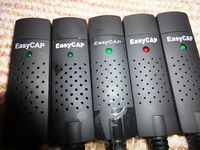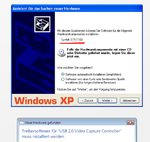Easycap: Difference between revisions
(identify before buy) |
|||
| Line 18: | Line 18: | ||
[http://www.logilink.de/showproduct/VG0001.htm Example where the chipset is declared] |
[http://www.logilink.de/showproduct/VG0001.htm Example where the chipset is declared] |
||
=== Installationinstructions for Windows === |
=== Installationinstructions for Windows === |
||
If the chipset is not mentioned in device specifications on the website, one way to figure out the chipset inside the EaysCAP is to read through the installationinstructions for Windows (if provided for download). |
[[File:windows-installer.png|right|150px]]If the chipset is not mentioned in device specifications on the website, one way to figure out the chipset inside the EaysCAP is to read through the installationinstructions for Windows (if provided for download). |
||
Screenshots of the windowsinstaller often reveal the devicename. |
Screenshots of the windowsinstaller often reveal the devicename. |
||
== STK1160 EasyCAP == |
== STK1160 EasyCAP == |
||
Revision as of 09:49, 14 August 2012
Many USB video capture devices are sold as EasyCAP, but EasyCAP is not a companys or brand name.
This name is used for some completly hardware different cheap clones of this USB analogue audio- and videocapturedevice which are vastly sold in onlineshops.
This article describes, how to identify the chipset of the known EasyCAP devices and if they are supported/ working on Linux.
Common technical features of "all" EaysCAP devices
- All the EasyCAP devices and clones need a USB 2.0 connection.
- They can capture analogue video up to 720x576 px (PAL) or 720x480 px (NTSC) and
- stereosound up to 48000 Hz sampling rate (or only 8000 Hz mono on some models where the ac97 chip is missing)
- Most of them have input cables labelled CVBS, S-VIDEO, AUDIO(L), AUDIO(R).
- Some models do have 4 yellow input cables (CVBS) labelled 1, 2, 3, 4 and one white unlabelled audio cable.
Indentify your device before buying
It is hard to identify the chipset of any EasyCAP device before buying because most onlineshops do not mention in the technical data the chipset of the device. Example where the chipset is declared
Installationinstructions for Windows
If the chipset is not mentioned in device specifications on the website, one way to figure out the chipset inside the EaysCAP is to read through the installationinstructions for Windows (if provided for download).
Screenshots of the windowsinstaller often reveal the devicename.
STK1160 EasyCAP
For the stk1160 based EasyCAPs exists another article on this wiki with further information!
It is assumed that the stk1160 based "EasyCAP DC60" ist the "originally" EasyCAP device. This device is sold in three different varieties (models) and even under different names like: LogiLink, Mumbi, Weltbild, and some more.

